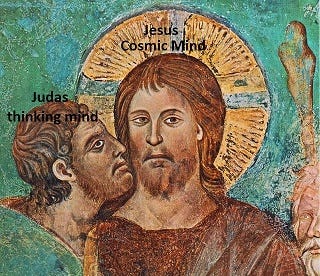
When Jesus sat among his disciples and said, “One of you will betray me,” he wasn’t foretelling tragedy; he was seeing the movement of the self. His centre was still, unmoving, timeless. From that stillness, he could see how the mind of another — Judas — was leaning, how the self was beginning to form and move toward its act.
Judas’s betrayal was not evil in the moral sense. It was the movement of separation itself — the self trying to define truth from outside the centre. The betrayal was a cosmic event replayed in human form: the moment awareness separates from stillness to know itself. That separation is the beginning of time, of karma, of suffering.
The moment the self moves, karma begins — not as punishment, but as psychological gravity. The self creates an orbit of tension, an imbalance that must return to stillness. This return is what we call the dissolution of karma. The centre never moves; only the self does. And when that movement is seen clearly, when there is no effort to correct or control it, the motion stops. The self dissolves, and the weight of karma disappears instantly.
This is the meaning of Judas’s remorse and death — not divine retribution, but the natural collapse of the self’s orbit back into the stillness it left. The suffering is not the centre punishing the self; it is the self exhausting its movement.
Krishnamurti said, “Do nothing. Just see.” He was describing this same return. The mind cannot dissolve karma by effort because effort is movement. It can only dissolve by seeing its own motion without choice. To see clearly is to end movement. The centre needs no purification — it was never touched.
Jesus knew this in silence. His crucifixion was not sacrifice but demonstration: the still centre meeting the chaos of the self and remaining unmoved. His words, “Forgive them, for they know not what they do,” came from the centre that sees without judgement — the awareness that knows the self is lost in its own movement, believing in choice where there is only cause and effect.
This is the law of karma, not as moral accounting, but as balance in consciousness. The self moves away from stillness, creating resistance. Suffering begins. The self exhausts itself in its struggle, and in the seeing of its futility, returns. Karma ends the moment there is nothing left to continue it.
The Buddha called this cessation. Krishnamurti called it insight. Jesus called it the Kingdom within. All were describing the same mechanism: when awareness returns to stillness, time ends, karma ends, and action flows without a self.
So the story of Jesus and Judas is not about betrayal and punishment. It is the story of every mind — the still centre and the self that leans from it, the movement that creates the world, and the seeing that brings it all home.
Karma, then, is not a sentence; it is a return. The only price is psychological suffering. The only liberation is the end of leaning.
The centre never leaves you. It waits in silence for movement to tire itself out.
And when it does, creation, forgiveness, and truth — all return to the same place: the unmoving centre of awareness, where there is no doer, no act, no past — only stillness.
Just remember what you did to Jesus with the thinking self:

